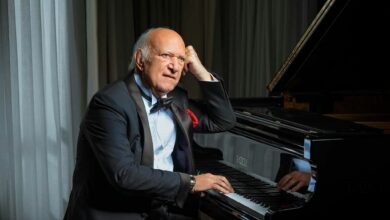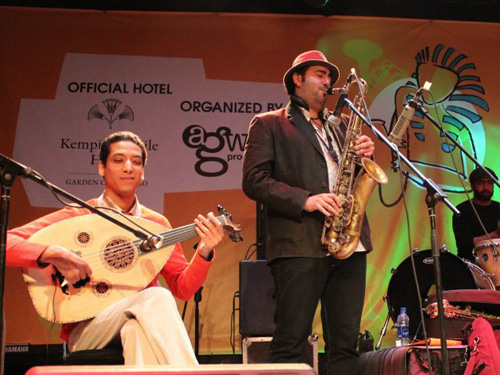The rift between mainstream and underground music bands and crooners became highly visible over the past decade, with the latter continuously marginalized by “official” media outlets. Prior to 25 January, underground musicians were excluded from popular radio stations, as well as national and satellite music channels, not to mention music production companies, either due to willful alliances with the state or pressure from State Security forces.
It was those same underground bands who participated in the Tahrir protests from day one, partly voicing their suffering under a despotic regime hostile to creativity and freedom of expression.
After Mubarak stepped down on 11 February, state and private media have been gradually trying to change face by occasionally airing revolutionary music such as “Sout al-Horreya” (Voice of Freedom) by Hany Adel and Amir Eid. Still, many are skeptical that the shift reflects real change in politics of the local music scene.
“Current attempts to showcase underground musicians remain distorted by the state’s tendency to guide and censor everything,” says lyricist and journalist Mohamed Kheir.
In the mid-2000s, the Mubarak regime was forced to loosen its grip on cultural production and the press in the face of pressure from the Bush administration to undergo structural democratic reform. This was reflected in the emergence of new non-state-affiliated press, social networking websites and blogging. A number of cultural spaces promoting contemporary art and music were also allowed to open.
These spaces, as well as online social media, became the main outlets available for underground musicians.
The privately owned El Sawy Culture Wheel opened in Cairo in 2003. Acquainted with professional marketing and publicity strategies, the Culture Wheel succeeded in attracting audiences, striking a balance between hosting quality performances and remaining profitable. Several nonprofit cultural NGOs followed suit, yet with less commercial orientations.
“Nonprofit NGOs and private spaces complement one another,” says Kheir. “The first promotes culture that is not necessarily commercial and the latter invades the market and promotes quality productions. Both play a better role than the state that still tries to control cultural production and doesn’t get what’s happening on Facebook and Twitter.”
These spaces attracted a significant audience base of young middle-class Egyptians, as the music they played resonated with the segment’s ambition for social change. Demand for live concerts rose, reflecting a break from common traditions of music consumption in Egypt.
“It can be said that underground musicians and bands began a parallel movement to the commercial one starting in 2005. Despite financial and logistical obstacles, enthusiastic young artists showed persistence and pulled people toward their creative artistic model,” explains Taimour Sameh, an events coordinator and artist manager.
This was no easy task, though, as it takes a lot of effort to change cultural habits and encourage people to enjoy art on the street, he adds. It was then that underground bands like “Wust el Balad” and “Black Theama” released their first albums and gained some popularity in the commercial market.
The struggle of many independent artists, to get fair media coverage and production deals, is expected to become more fruitful after the revolution in an atmosphere that favors creativity and approaches youth experience more openly. Still, the management of cultural spaces in Egypt has not developed to meet artists’ expectations.
“To stage your work, you either have to deal with a bureaucratic and corrupt Culture Ministry or independent NGOs that are often impeded by their elitist taste and narrow array of artists and audience,” says Mohamed Mohsen, a singer whose band plays socially-engaged contemporary oriental music.
Mohsen criticizes an inherent anomaly in developing the underground scene in Egypt. For many reasons, including limited funds and freedom, music agents prefer to play it safe, producing music for their regular guaranteed audience.
“I believe it would take years for such politics to change and offer equal chances to pop, folk and independent artists alike. It’s similar to all the outcomes of the revolution that get actualized very slowly,” contends Mohsen.
“Private sector investment in culture by enlightened Egyptian businessmen is a potential solution to the music industry’s problems. State interference in production would further hinder change, as the state ministry gives priority to people aligned with it and does not apply quality and transparency standards,” says Sami Kamal Eddin, an art critic and novelist.
And despite independent artists having no tangible reason to be hopeful, there are preliminary signs of change on the scene, with less money going into commercial music production.
“Big companies and artists will watch carefully before spending money on new drama or music productions, maybe to re-adjust themselves to the mood of a youthful audience getting more involved in everyday politics. This will definitely require innovative steps from their side,” explains Kheir.
Increasing internet piracy is also leading to dwindling revenues and negatively impacting the number of yearly productions. Campaigns to track and block piracy websites and encourage buying original copies of music albums have mostly failed.
“Post-revolution, people want to attend more music concerts. Paying for cultural consumption, however, is not a deeply ingrained cultural value in our society,” argues Sameh.
Besides piracy, the potential Islamization of cultural industries emerges as a major threat to the music scene, with some artists afraid of judgment and censorship.
“The political atmosphere after the coming elections will have a crucial role in supporting or discouraging free artistic practice. Still, music and song in the age of new media will become the easiest, most propagated and least expensive art of resistance,” says Kheir.




